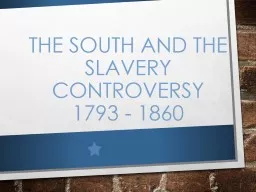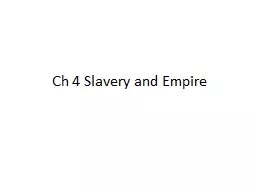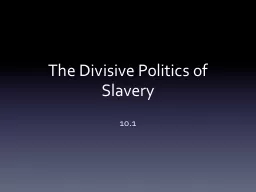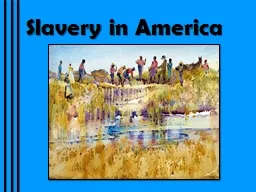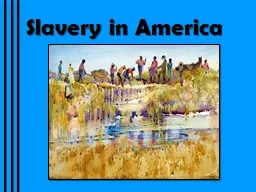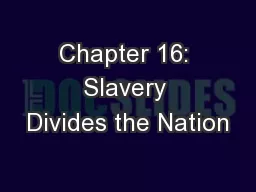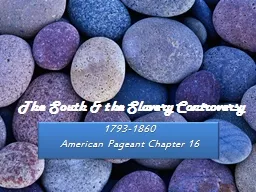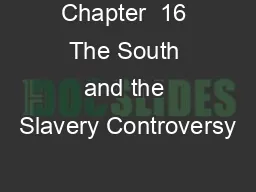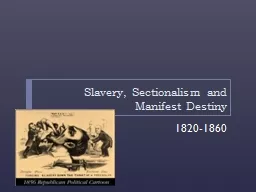PPT-The South and the Slavery
Author : calandra-battersby | Published Date : 2016-09-08
Controversy 1793 1860 Cotton is King Cotton Gin Demand for slavery Cotton D ominant Southern crop Cotton Kingdom Agricultural Factory More slaves land
Presentation Embed Code
Download Presentation
Download Presentation The PPT/PDF document "The South and the Slavery" is the property of its rightful owner. Permission is granted to download and print the materials on this website for personal, non-commercial use only, and to display it on your personal computer provided you do not modify the materials and that you retain all copyright notices contained in the materials. By downloading content from our website, you accept the terms of this agreement.
The South and the Slavery: Transcript
Controversy 1793 1860 Cotton is King Cotton Gin Demand for slavery Cotton D ominant Southern crop Cotton Kingdom Agricultural Factory More slaves land Cotton ½ value of American exports after 1840. 18th century, most slaves recent arrivals, work on small farms. By 1830, majority are American, work on plantations or large farms. Rural Slavery. On plantations, men, women, children work dawn to dusk in fields. Essential Questions. How did the modern system of slavery develop?. What was the history of the slave trade and the Middle Passage?. How did Africans manage to create communities among the brutal slave system?. 10.1. Industry in the North. 1850’s –more than 20,000 miles of track laid. Cities transformed over night. Many immigrants came. Strongly opposed to slavery. Agriculture in the South. 1850 . 1/3 of the nations population was in the South. Fitzhugh’s . Sociology for the South. , 1854. Sociology for the South. , 1854. Sociology for the South, or, the Failure of Free Society. (1854) was George Fitzhugh’s . attack . on the philosophical foundations of free . Slavery’s Evolution. At the beginning of the 18th century, most slaves were born in Africa, few were Christian, and very few slaves were engaged in raising cotton. By the start of the American Revolution, slavery had changed dramatically. Slavery’s Evolution. At the beginning of the 18th century, most slaves were born in Africa, few were Christian, and very few slaves were engaged in raising cotton. By the start of the American Revolution, slavery had changed dramatically. Crispus. Attucks in the Mob at the “Boston Massacre,” 1770. Phillis. Wheatley, Boston Slave and Published Poet. Slavery and Slave Revolt as a Cause of the American Revolution. Centrality of Slavery to British North America. 16.1 – Slavery in the Territories. From the days of Jefferson and the Founding Fathers, slavery was a major issue for politicians. The Missouri Compromise. By 1819, there were 22 states (11 free, 11 not). 1793-1860. American Pageant Chapter 16. “Cotton is King!”. King Cotton. Cotton Gin—revives slavery. South & others profited. ½ of American exports after 1840. Produced more than ½ world’s supply. Chapter 6, Section 1. Slavery Divides the Union. After the United States had gained independence from Great Britain, the North and the South developed very differently. The North’s economy concentrated on . Explain . the impact of the Missouri Compromise on the admission of states from the Louisiana Territory. . b. Examine James K. Polk’s presidency in the fulfillment of Manifest Destiny including the Texas annexation and Oregon. . Plantation Agriculture. Wasteful. Excessive cultivation of cotton despoiled the land. Weaknesses of the plantation system. 1. Relied on one crop. 2. Repealed European immigrants. 3. Significant population moved West. 1820-1860. The South and the Slavery Controversy. Chapter 16. I. Cotton is King. After Revolution slavery faced an uncertain future, it was logical to think slavery would fade away. Invention of the cotton gin in 1793 changed that. - Frederick Douglass. Frederick Douglass. “I expose slavery in this country, because to expose it is to kill it. Slavery is one of those monsters of darkness to whom the light of truth is death.” .
Download Document
Here is the link to download the presentation.
"The South and the Slavery"The content belongs to its owner. You may download and print it for personal use, without modification, and keep all copyright notices. By downloading, you agree to these terms.
Related Documents

